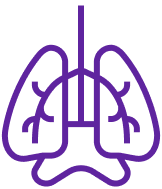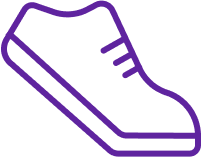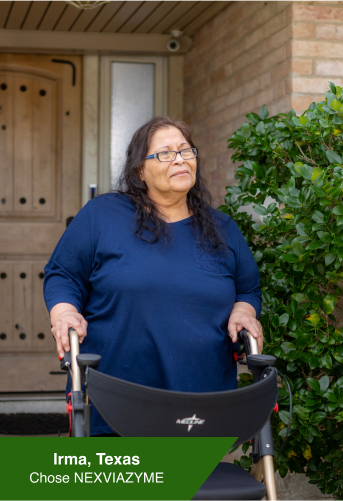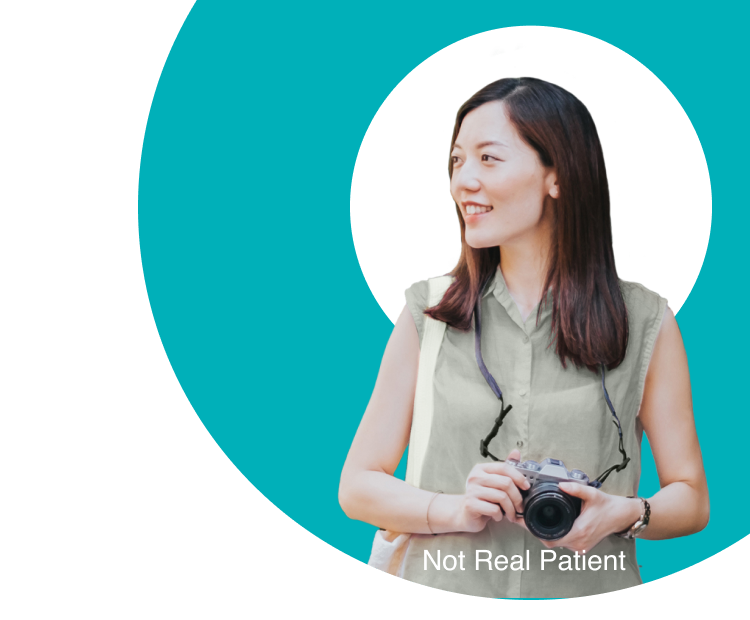Being informed helps you advocate for yourself or a loved one

What is Pompe disease?
Pompe is a degenerative muscle disease that causes muscle weakness when the body doesn’t have enough of the GAA enzyme. Normally, this enzyme breaks down a type of sugar called glycogen that muscle cells can store or use for energy. But with Pompe, the glycogen continues to build up and causes muscle damage.
Late-onset Pompe disease (LOPD); the most common type, is progressive, meaning it gets worse over time, so breathing and walking can become harder to do.
BE ALERT
What are the symptoms of LOPD?
Everyone’s experience with Pompe is different, but there are number of common symptoms outlined here.
Please know that this is not an all-inclusive list. Talk to your doctor about all of your symptoms.

Breathing
With LOPD, you always want to pay attention to your breathing. These common symptoms can help you know what to look for, but it’s not an all-inclusive list.
-
Difficulty breathing deeply
-
Difficulty breathing when lying down
- More breathless during and/or after exercise
- Waking up throughout the night feeling breathless
- Weak cough
- Shortness of breath while lying down
- Reduced ability to fully exhale
- Breathing failure
- Morning headaches
- Daytime sleepiness
- Poor sleep quality
- Fragmented sleep
- Sudden shortness of breath during sleep
- Trouble breathing during sleep
Other common breathing symptoms:
Some symptoms to be aware of after or during sleep:
.png)
Movement & Walking
You’ll find some common movement-related symptoms here. Which ones sound familiar? Again, this is not an all-inclusive list, so always tell your doctor about all of your symptoms.
- Harder to climb stairs
- Difficult maintaining balance while walking or standing
- More trouble reaching over the head
- More difficulty with everyday tasks, like washing or brushing hair
- More difficulty beginning or continuing exercise
- Walking with swaying hips or a waddle
- Frequent trips or falls
- Increasing muscle weakness and/or pain over time
Other common symptoms:
POMPE 101
The two types of Pompe
Infantile-onset, or IOPD*
IOPD presents within the first year of life. Signs and symptoms include an enlarged heart, motor delays, difficulty breathing, and failure to thrive.
*NEXVIAZYME is not approved for the treatment of IOPD.
Late-onset, or LOPD
LOPD can present at any age and commonly affects muscle groups used in breathing and walking. Eventually, people living with LOPD may need assistance walking or devices to help with breathing.
Learning to live with Pompe
Understanding Pompe is the first step to knowing what to expect and the best ways to manage your particular situation. This video can help.
POMPE GENETICS
How Pompe is inherited
Genes are made up of DNA and carry the instructions that tell the body how to grow and function. You inherit 2 copies of every gene, 1 copy from your mother and 1 copy from your father. Changes to genes—called variants—can affect how well they work. The gene involved with LOPD is called the GAA gene.
Someone with 1 disease-causing variant of the GAA gene is a “carrier” of LOPD. When 2 carriers for LOPD have children together, their child may inherit the disease, become a carrier, or be unaffected.
Early diagnosis can lead to earlier disease management. That’s why it’s recommended that close family members of someone with LOPD get tested. Click through the scenarios below to get an understanding of how LOPD is passed through families.
-
Scenario 1
Here is an example. When both parents are carriers, there is a:
- 25% chance that the child will receive 2 gene variants and thus inherit the disease
- 50% chance that the child will inherit only 1 gene variant and become a carrier
- 25% chance that the child will be completely unaffected
These chances remain the same for every pregnancy.Scenario 1
Here is an example. When both parents are carriers, there is a:
- 25% chance that the child will receive 2 gene variants and thus inherit the disease
- 50% chance that the child will inherit only 1 gene variant and become a carrier
- 25% chance that the child will be completely unaffected
These chances remain the same for every pregnancy. -
Scenario 2
When one parent has Pompe and the other parent is unaffected, all children will be carriers
These chances remain the same for every pregnancy.Scenario 2
When one parent has Pompe and the other parent is unaffected, all children will be carriers
These chances remain the same for every pregnancy.

How to test for Pompe
Pome is rare, affecting about 1 in 40,000 people, so it can take time to get a definitive diagnosis. Your doctor is the best source of information, and can run tests to help determine if it's Pompe:
• Genetic test showing abnormalities in the GAA gene
• Blood test or biopsy showing decreased GAA enzyme activity
CareConnectPSS® has been dedicated to the Pompe community for more than a decade, and has helped many newly diagnosed people navigate this difficult time.
KEEP TRACK OF YOUR POMPE
Ask your doctor
When you have Pompe disease, it’s important to keep track of your symptoms, because even small changes matter. Use this self-assessment regularly and talk to your doctor about how you’re doing.
|
WARNING: SEVERE HYPERSENSITIVITY REACTIONS, INFUSION-ASSOCIATED REACTIONS, and RISK OF ACUTE CARDIORESPIRATORY FAILURE IN SUSCEPTIBLE PATIENTS |
WARNINGS AND PRECAUTIONS
Hypersensitivity Reactions Including Anaphylaxis: See Boxed WARNING. Your doctor may decide to give you antihistamine, anti-fever and/or steroid medications before your infusions. Your doctor should consider the risks and benefits of restarting the infusion if you have a severe hypersensitivity reaction (including anaphylaxis) to NEXVIAZYME. If a mild or moderate hypersensitivity reaction occurs, your healthcare provider may slow the infusion rate or temporarily stop the infusion.
Infusion-Associated Reactions (IARs): See Boxed WARNING. Your doctor may decide to give you medications before your infusions to decrease the risk of IARs; however, IARs may still occur after receiving these medications. If mild or moderate IARs occur, your healthcare provider should consider decreasing the infusion rate or temporarily stopping the infusion which may help improve the symptoms.
Risk of Acute Cardiorespiratory Failure in Susceptible Patients: See Boxed WARNING.
ADVERSE REACTIONS
The most common adverse reactions (>5%) were headache, fatigue, diarrhea, nausea, joint pain, dizziness, muscle pain, itching, vomiting, shortness of breath, rash, “pins-and-needles” sensation, and hives.
INDICATION
NEXVIAZYME (avalglucosidase alfa-ngpt) is used for the treatment of patients 1 year of age and older with late-onset Pompe disease [lysosomal acid alpha-glucosidase (GAA) deficiency].
Please see full Prescribing Information for complete details, including Boxed WARNING.
|
WARNING: SEVERE HYPERSENSITIVITY REACTIONS, INFUSION-ASSOCIATED REACTIONS, and RISK OF ACUTE CARDIORESPIRATORY FAILURE IN SUSCEPTIBLE PATIENTS |
WARNINGS AND PRECAUTIONS
Hypersensitivity Reactions Including Anaphylaxis: See Boxed WARNING. Your doctor may decide to give you antihistamine, anti-fever and/or steroid medications before your infusions. Your doctor should consider the risks and benefits of restarting the infusion if you have a severe hypersensitivity reaction (including anaphylaxis) to NEXVIAZYME. If a mild or moderate hypersensitivity reaction occurs, your healthcare provider may slow the infusion rate or temporarily stop the infusion.
Infusion-Associated Reactions (IARs): See Boxed WARNING. Your doctor may decide to give you medications before your infusions to decrease the risk of IARs; however, IARs may still occur after receiving these medications. If mild or moderate IARs occur, your healthcare provider should consider decreasing the infusion rate or temporarily stopping the infusion which may help improve the symptoms.
Risk of Acute Cardiorespiratory Failure in Susceptible Patients: See Boxed WARNING.
ADVERSE REACTIONS
The most common adverse reactions (>5%) were headache, fatigue, diarrhea, nausea, joint pain, dizziness, muscle pain, itching, vomiting, shortness of breath, rash, “pins-and-needles” sensation, and hives.
INDICATION
NEXVIAZYME (avalglucosidase alfa-ngpt) is used for the treatment of patients 1 year of age and older with late-onset Pompe disease [lysosomal acid alpha-glucosidase (GAA) deficiency].
Please see full Prescribing Information for complete details, including Boxed WARNING.

